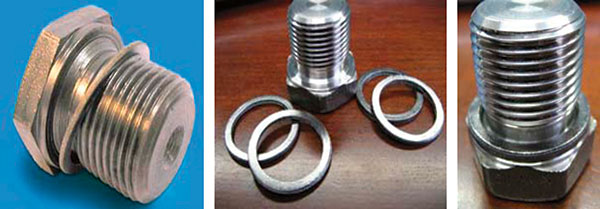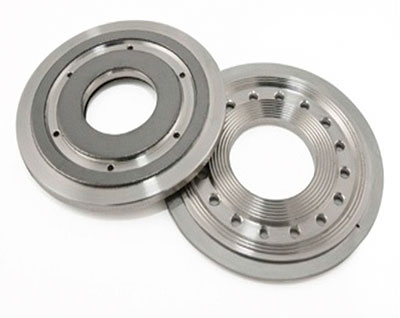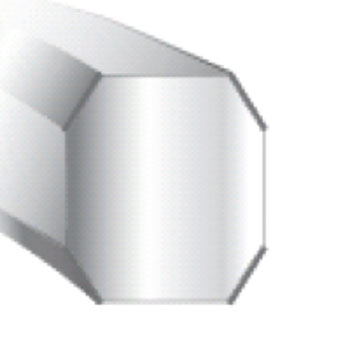Pumps & Systems, March 2013
Grooved metal gaskets with covering faces, often called kammprofile gaskets, consist of a metal core with grooves or serrations in each face. They can be supplied with or without a guide ring.
Soft material—such as polytetrafluoroethylene (PTFE), flexible graphite or other high temperature facing—is applied to both sides of the concentric serrated sealing core. It is a problem solver for heat exchangers and large vessels since it provides one of the tightest seals combined with superior load bearing characteristics.
Preferred in Rigorous Applications
Kammprofile gaskets are a preferred design when improved performance at low seating stresses is required. Their M values, Y stresses and other gasket constants are lower than those of grooved metal gaskets without any facings, other reasons for their preference. Metal to metal contact seals require a higher degree of loading.
While the facing materials are typically soft and easy to seal, the deep grooves keep the facing from extruding under high compressive loads or internal pressures. Kammprofile gaskets have the ability to seal at low compressive stresses, but they also handle higher compressive loads and high internal pressures, making them unique problem solvers.
Dimensional Flexibility
Another important use of kammprofile gaskets is when the exact contact dimensions of a flange are unknown prior to opening the joint.
It may be known that an existing flange has a raised face (RF), but its exact outside diameter (OD) may not be available until the old gasket is removed. A spiral wound gasket must be sized so that the windings start and end on the flange.
If the inside diameter (ID) of the windings is smaller than the flange contact area or the OD of the windings is beyond the OD of the RF, the windings may buckle. This is not a concern for a kammprofile gasket. It can hang over the RF’s OD without damaging the gasket.
Typical Kammprofile Gasket Designs
Three typical designs are available—a gasket without a guide ring, with a guide ring and with a loose-fit guide ring. A kammprofile gasket without a guide ring can be applied in recessed flange applications—such as tongue-and-groove connections or a heat exchanger application—to replace double-jacketed gaskets as an upgrade design (see Figure 1). Note that when a nubbin is present in the sealing area, it is strongly recommended that it be removed when upgrading from a double-jacketed design. This type kammprofile gasket is acceptable in standard pipe flanges as long as the gasket is sized to center itself on the bolts.
Kammprofile gaskets with a guide ring are manufactured with an integral guide ring for centering (see Figure 2). These are recommended for application in RF, ASME B16.5 pipe flanges and also can be sized to EN 12560-6 specifications.
Kammprofile gaskets with a loose-fit guide ring are applied to nominal pipe size and pressure class flanges and used when thermal cycling expansions and contractions are present (see Figure 3). The gasket is designed to comply with either ASME B16.5 flange or EN 12560-6 specifications.

Figure 1. Design without a guide ring

Figure 2. Design with guide rings

Figure 3. Design with a loose-fit guide ring
Other Gasket Designs
The kammprofile grooves or serrations can be applied as an upgrade to a typical flat metal washer, which can be difficult to seal. Flat washers might be used on a “plug” type threaded application, where the head of the plug will turn down against the washer. Solid metal washers can be tough to seal, of course. These plugs are common on air cooler or fin fan heat exchangers. Typical heat exchanger plugs with this type washer are shown in Image 1.

Image 1. Typical heat exchanger plugs with solid metal washers
Kammprofile gaskets can also be designed as a dual seal solution with leak detection device incorporated into flanged assemblies. These might be used in critical applications such as phosgene service. They have a primary inner sealing area with a relief section and holes on the outer portion of the sealing. Past these relief holes is a secondary sealing area that maintains the integrity of the bolted joint.

Image 2. Design with integrated leak detection
The kammprofile design with soft facing material can also be applied on the sealing area of ring joint gaskets.

Figure 4. Ring joint gasket
This is an ideal solution for applications in which cracking or embrittlement has occurred in ring joint flange grooves (see Figure 4). Kammprofile gaskets can be manufactured in different metal materials, shapes (circular and non-circular) and custom-engineered designs to fit different applications. The recommended flanges sealing surface finish is 125 to 250 microns per inch.
Conclusion
Grooved metal gaskets can effectively seal a wide range of applications because of their unique characteristics, design flexibility and facing material options. End users should consult their gasket manufacturer for recommendations for their specific applications. P&S
Next Month:
What are the important considerations for the proper torque of a valve packing gland?
We invite your suggestions for article topics as well as questions on sealing issues so we can better respond to the needs of the industry. Please direct your suggestions and questions to sealingsensequestions@fluidsealing.com.

